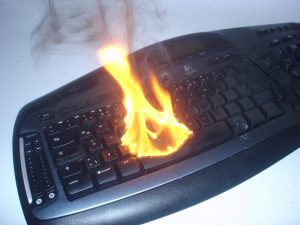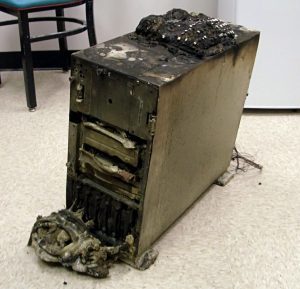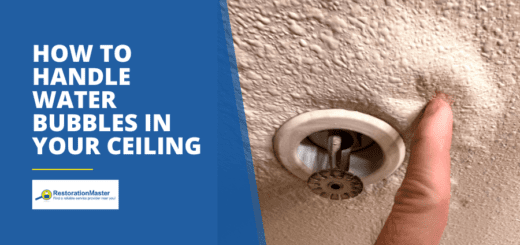How Smoke and Fire Affect Electronics
Whether extremely mild or blazing with intensity, fires and the resulting smoke are damaging to electrical components. Wispy smolders stream into the environment from cigarettes or cooking; and massive smoke and fire damage can erupt from a spontaneous electrical explosion.
Intentional flames, such as candles, living room fireplaces or oil lamps, also emit streams of steady smoke. These controlled fires engulf the air with smoke, which is a combination of gases, solids and liquid particles, making it a harsh byproduct of fire when it comes to delicate electronics.
The bottom line is that fire and smoke wreak havoc on electronics. The sootSoot is fine black particles composed of carbon and other ma... More and smoke that cover every inch a fire originally touched leaves damaged goods, like important electronics, in their wake. Once the fiery invaders have been extinguished, what’s left is a chemical, watery mess.
While the contents of a home or business take a devastating hit from a fire, valuable electronics especially suffer. Despite the seemingly tough, metal exteriors on computers, televisions, cell phones or appliances, the smoke and flames have a disastrous hold on these costly items.
Smoke Leads to Electronics Failing

Smoke can be an irritantAn irritant is a substance that causes temporary discomfort ... More to electronics, especially when the smoke steadily pollutes the environment. Slowly, over time, smoke within the space gently covers the exteriors of electronics, gradually layering upon them smoky materials that inhibit electronic devices from releasing heat. The result? Electronics become hotter and hotter; and, excessive temps reduce the lifespan of devices.
Cigarette smoke is a silent but equal menace to electronics, as well. The tar released from cigarette smoke gathers onto electronics, allowing dust to stick to these expensive items and limits its ability to discharge heat. When electronic devices overheat, they eventually break down.
Computers and electronics that feature circuit boards, like radios and televisions, suffer intense damage from smoke particles that surround them. When smoke gathers onto circuit boards, electrical currents start to flow—especially to areas where the currents are not intended. The catastrophic result is that these high-frequency devices start to function erratically. Your computer, for instance, might reboot itself unexpectedly.
Your electronics can fail due to solely to smoke. Accumulations of smoke on your devices cause electrical sparks to surge out of them. Dust and particles in the air are attracted to the static electrical fields that are emitted from high-voltage devices, leading to gradual failure.
Smoke is also acidic. Coats of smoke ensures corrosion will penetrate metal, glass and plastics—all elements within electronic devices. The sootSoot is fine black particles composed of carbon and other ma... More from fire, when combined with high levels of humidityHumidity is the amount of moisture or water vapor present in... More or liquid, like water, also increases the corrosive effects on the electronics.
Prevent Electrical Fires
Overheated electronics is one major cause of electrical fires. To decrease the chances of an electrical fire, make sure your electrical devices can properly ventilate heat. This means protect your electronic devices from exposure to smoke. Place electronics in rooms where frequent cigarette smoke or smoke from cooking cannot coat their fragile exteriors. Remember that electronic devices need to breathe and expel heat efficiently in order to properly function.
Another strategy to prevent an electrical fire is to keep electronics that dispel heat away from flammable or combustible materials.
Electronic appliances are another main culprit that causes fires. Leaving appliances unattended or running for extensive periods of time, like heaters blasting warm air during winter’s freezing temperatures, can dramatically increase the chances of a fire.
Keep your smoke detector in tip-top condition. The blaring alarm from a working smoke detector could save your property and its valuable electronic contents from severe fire and smoke damage.
The Financial Mess of Smoke and Fire

Fire and smoke can cause serious damage to computers and other electronics.
Homeowners or businesses affected by smoke and fire nearly empty their pockets for the cleanup of sootSoot is fine black particles composed of carbon and other ma... More and chemical extinguishers, as well as smoke damage restoration. On average, the cost of cleaning up fire and smoke damage ranges from $3,251 to $22,380, according to Home Advisor.
However, the greater or lesser extent of the smoke and fire damage helps determine your costs. The quicker you react to smoke and fire damage, the more likely it will be to restore your valuable belongings, including electronics, to their original state without undue financial hardship. SootSoot is fine black particles composed of carbon and other ma... More has a tendency to continue its damage when left untreated. So, it’s essential to react quickly to put the brakes on its relentless, destructive path.
Restore Electronics After Fire and Smoke Damage
Quick action is the most effective remedy once fire and smoke damage strikes your valuable electronics. Contacting a professional fire and smoke damage restorationRestoration is the process of returning a property to its pr... More specialist as soon as possible limits the extensive damage of smoke. RestorationMaster is one of Phoenix’s most trusted specialists when it comes to restoring fire and smoke damaged goods, including electronics.
Professionals trained in the restorative process of electronics use advanced machinery to clean up sootSoot is fine black particles composed of carbon and other ma... More, smoke and residues. RestorationMaster technicians use specific chemical processes to treat at-risk surfaces, like electronics.
The faster you call; the quicker fire and smoke restorationRestoration is the process of returning a property to its pr... More professionals can react. SootSoot is fine black particles composed of carbon and other ma... More gradually increases its disastrous effects over time, embedding itself deeper and deeper within materials and making it more difficult to restore. RestorationMaster is available 24 hours a day to take your call when emergency strikes. There’s no benefit in waiting to make that important call if fire and smoke damage makes its entrance into any portion of your home or business.
No job is too big or too small! A professional smoke and fire damage restoration specialist will handle every individual case with expertise. Your valuable electronics are at stake, so why wait to restore them in the event of fire or smoke damage? The life of your electronics can be saved with professional restorative techniques that only experienced and trained fire and smoke damage specialists are equipped to provide.












